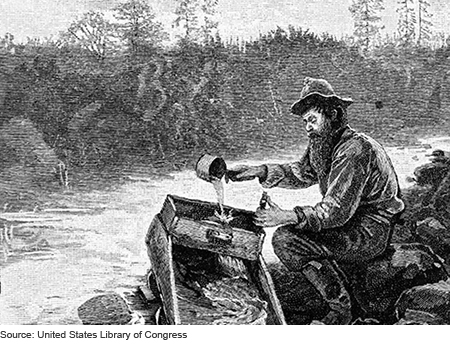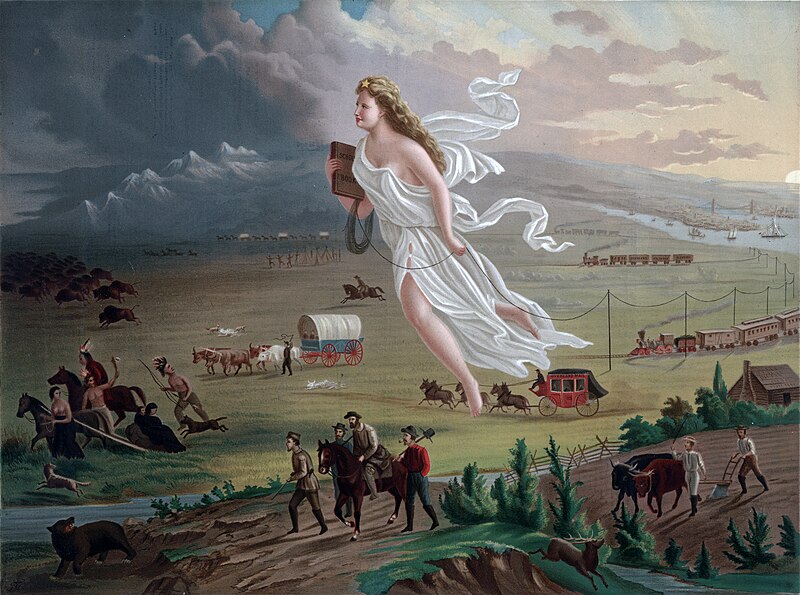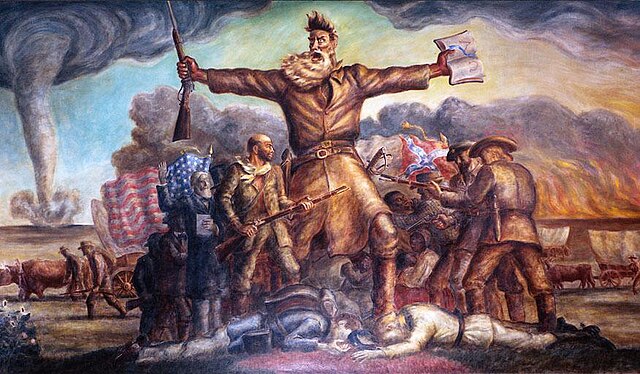What was the Panic of 1837, and what caused it?
A) It was a widespread economic depression caused by the collapse of the national banking system and excessive land speculation.
B) It was a temporary stock market crash caused by the overproduction of crops.
C) It was a financial crisis caused by the decline in the gold supply in the United States.
D) It was a recession triggered by the end of the War of 1812 and trade restrictions.
A) It was a widespread economic depression caused by the collapse of the national banking system and excessive land speculation.

How did the discovery of gold in areas like Georgia and later California contribute to urbanization in the United States?
A) It encouraged the building of railroads and development of new cities around mining areas.
B) It led to the establishment of military forts in rural areas.
C) It increased agricultural development, which led to a decrease in city populations.
D) It caused large migrations of people out of the United States.
A) It encouraged the building of railroads and development of new cities around mining areas.
The Second Great Awakening was a movement that promoted —
A. spiritual revival and the need for social reform
B. the use of reason and scientific theory
C. states’ rights and governmental reform
D. mercantilism and the development of global trad
A. spiritual revival and the need for social reform
A. fighting broke out between pro-slavery and anti-slavery groups in Kansas.
B. Kansas entered the Union as a slave state through popular sovereignty in 1856.
C. Nebraskan settlers who supported abolition moved to Kansas.
D. The boundary established by the Missouri Compromise of 1820 was extended farther south.
A. fighting broke out between pro-slavery and anti-slavery groups in Kansas.
In the Gettysburg Address, President Abraham Lincoln said the United States was dedicated to the idea that:
A) All men are created equal
B) The South should have its own government
C) Slavery should be expanded
D) Voting rights should be limited
A) All men are created equal
The Indian Removal Act of 1830 authorized the U.S. government to:
A) Grant Native American tribes the right to self-governance
B) Relocate Native American tribes living in the southeastern U.S. to lands west of the Mississippi River
C) Abolish slavery in all U.S. territories
D) Protect Native American lands from European settlement
B) Relocate Native American tribes living in the southeastern U.S. to lands west of the Mississippi River
Which event was one cause of the U.S.-Mexican War?
A. The United States banned slavery in territories acquired from Mexico.
B. The U.S. Congress debated statehood for New Mexico.
C. U.S. and Mexican soldiers fought over disputed territory north of the Rio Grande.
D. The United States acquired the Mexican Cession.
C. U.S. and Mexican soldiers fought over disputed territory north of the Rio Grande.
Which title best completes this diagram?
A. Innovations in the Cottage Industry
B. Causes of Rural Development
C. Expansion of Employees’ Rights
D. Reasons for Urbanization
D. Reasons for Urbanization
What was one effect of the Fugitive Slave Act of 1850?
A. The Republican Party lost influence in the federal legislature.
B. The Missouri Compromise was deemed unconstitutional by federal courts.
C. Tensions among the populations of northern and southern states increased.
D. Immigrants were forced to relocate from eastern cities to western territories.
C. Tensions among the populations of northern and southern states increased.
Frederick Douglass was an influential leader in the abolitionist movement. Which of the following statements best describes one of his key contributions to the fight against slavery?
A) He led a military campaign to free enslaved people in the South.
B) He escaped slavery and used his experiences to write and speak powerfully against it, inspiring many to join the abolitionist cause.
C) He founded a colony in Africa for formerly enslaved people.
D) He served as a Supreme Court justice who ruled in favor of ending slavery.
B) He escaped slavery and used his experiences to write and speak powerfully against it, inspiring many to join the abolitionist cause.
What was the issue in Worcester v. Georgia?
A. The taxation of Cherokee lands
B. The use of subsistence farming by the Cherokee people
C. The sovereignty of the Cherokee nation
D. The abandonment of the Cherokee culture by its people
C. The sovereignty of the Cherokee nation
As a result of the Oregon Treaty, the United States achieved its goal of —
A. expanding westward to the Pacific Ocean
B. acquiring land for a southwestern railroad
C. reserving western territory for American Indians
D. securing the southern border of the country
a. expanding westward to the Pacific Ocean
Which of the following statements is an example of transcendentalism?
A. Accepting the teachings of the church and sharing them
B. Having total faith in your government and letting it lead you
C. Being your best through self-reliance and peace with nature
D. Seeking out the beliefs of the majority and following them
C. Being your best through self-reliance and peace with nature
The "Tariff of Abominations" (Compromise of 1828) angered many Southern states because:
A) It reduced the cost of European goods, making Southern goods less competitive.
B) It imposed high taxes on imports, raising prices on goods the South relied on.
C) It required Southern states to grow only cotton.
D) It prohibited trade with any country outside the United States.
B) It imposed high taxes on imports, raising prices on goods the South relied on.
What was the primary purpose of the Freedmen's Bureau, established after the Civil War?
A) To promote Southern secession from the Union
B) To help formerly enslaved people and poor whites with education, housing, and employment
C) To create new laws to restrict the rights of African Americans in the South
D) To oversee military operations in the Reconstruction South
B) To help formerly enslaved people and poor whites with education, housing, and employment
The Nullification Crisis of 1832 was a conflict between the federal government and the state of South Carolina over which of the following issues?
A) Slavery laws
B) States' rights to declare federal laws invalid
C) Expansion of western territories
D) Voting rights for citizens in new states
B) States' rights to declare federal laws invalid

Which statement explains one of the motivations behind Manifest Destiny?
A. "These are the times that try men's souls: the summer soldier and the sunshine patriot will, in this crisis, shrink from the service of his country...."
B. "I do order and declare that all persons held as slaves within said designated States, and parts of States, are, and henceforward shall be free...."
C. "And that claim is by the right... to overspread and to possess the whole of the continent which Providence has given us...."
D. "That it is the duty of the women of this country to secure to themselves their sacred right to the elective franchise."
C. "And that claim is by the right... to overspread and to possess the whole of the continent which Providence has given us...."
Why did Congress honor this woman by putting her on a coin?
A. Because she was an influential First Lady
B. Because she designed the nation’s first flag
C. Because she fought for women’s suffrage
D. Because she was the first woman elected to Congress
C. Because she fought for women’s suffrage
The 1857 Supreme Court decision in Dred Scott v. Sandford ruled that:
A) Slaves were considered citizens with the right to sue in federal court.
B) Congress had the power to prohibit slavery in any U.S. territory.
C) African Americans, whether free or enslaved, were not U.S. citizens and had no legal rights.
D) All enslaved people would be freed if they moved to a free state.
C) African Americans, whether free or enslaved, were not U.S. citizens and had no legal rights.
Which of the following was a key difference between the Union and the Confederacy during the Civil War?
A) The Union supported slavery, while the Confederacy opposed it.
B) The Union had a stronger industrial economy, while the Confederacy had a more agricultural-based economy.
C) The Union fought to preserve states' rights, while the Confederacy fought to strengthen federal power.
D) The Union was led by Robert E. Lee, while the Confederacy was led by Abraham Lincoln.
B) The Union had a stronger industrial economy, while the Confederacy had a more agricultural-based economy.

What was the primary impact of the Tariff of Abominations during Andrew Jackson's presidency?
F. It led to increased support for protective tariffs, boosting domestic industries.
G. It resulted in a decrease in government revenue due to reduced import duties.
H. It sparked heated debates and tensions between the North and the South over economic policies
J. It had little effect on the economy as it was quickly repealed by Congress.
H. It sparked heated debates and tensions between the North and the South over economic policies
How did Chinese, Irish, and German immigrants contribute to the westward expansion of the United States in the 1800s?
A) By working as political leaders who encouraged expansion policies
B) By serving as soldiers who fought against Native American tribes
C) By building infrastructure like railroads, which connected the east to the west
D) By establishing colonies that remained independent of U.S. law
C) By building infrastructure like railroads, which connected the east to the west
Which effect did these innovations have on life in the United States?
A. Natural fertilizer became more effective.
B. Harvesting season could last longer.
C. Finding water to irrigate crops became easier.
D. Crop production became more efficient.
D. Crop production became more efficient.

John Brown's 1859 raid on the federal arsenal at Harpers Ferry was intended to:
A) Capture weapons to arm Native American tribes in resistance against U.S. expansion
B) Spark a large-scale slave uprising by arming enslaved people in the South
C) Seize control of a strategic military site for the Confederate army
D) Force the government to pass laws that would gradually end slavery
B) Spark a large-scale slave uprising by arming enslaved people in the South

Which of the following was a significant consequence of sharecropping for freed African Americans in the post-Civil War South?
A) It provided them with economic independence and landownership
B) It often trapped them in a cycle of debt and poverty due to unfair contracts with landowners
C) It encouraged the migration of African Americans to northern cities in large numbers
D) It gave them full voting rights and political power in Southern states
B) It often trapped them in a cycle of debt and poverty due to unfair contracts with landowners